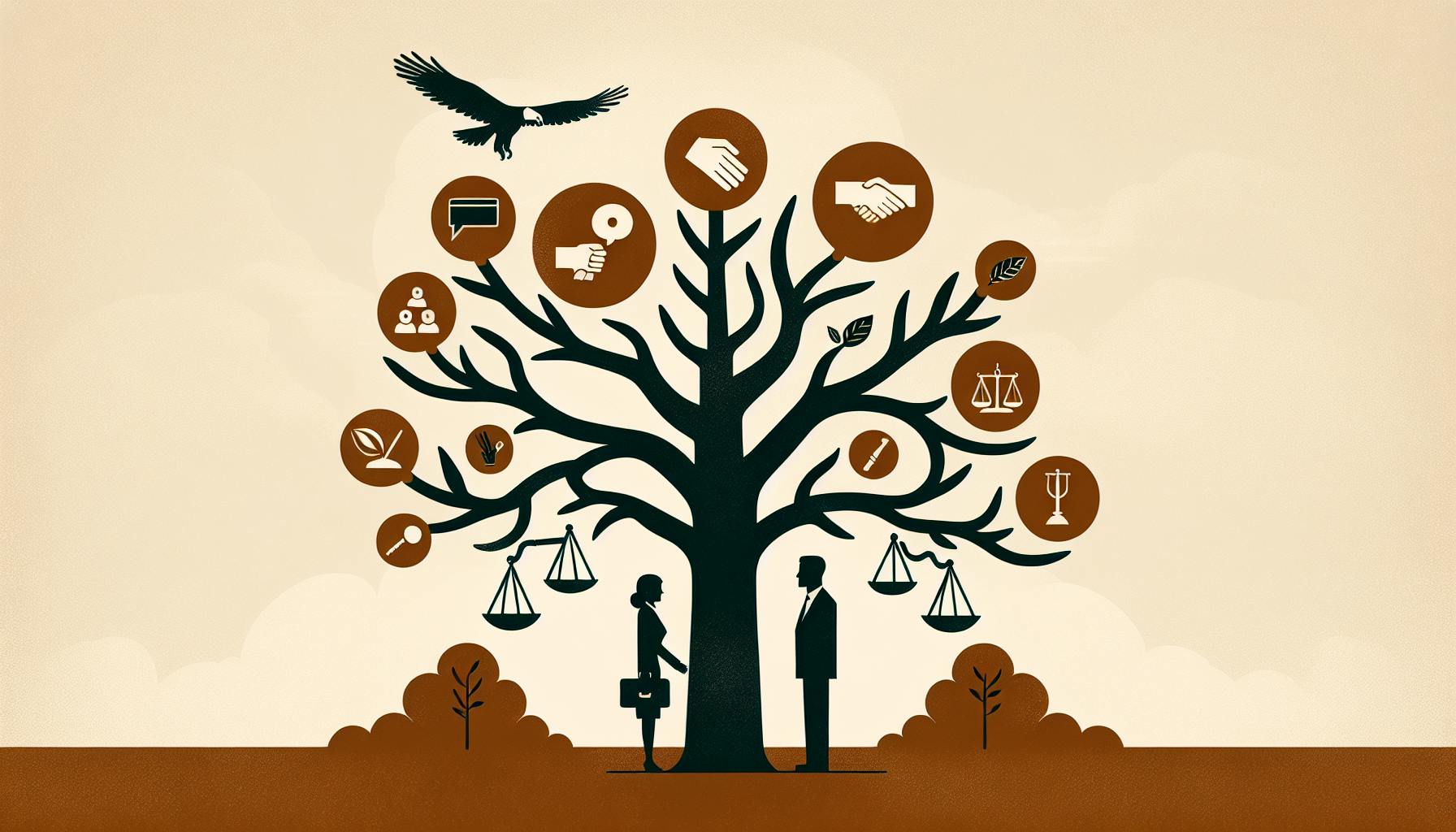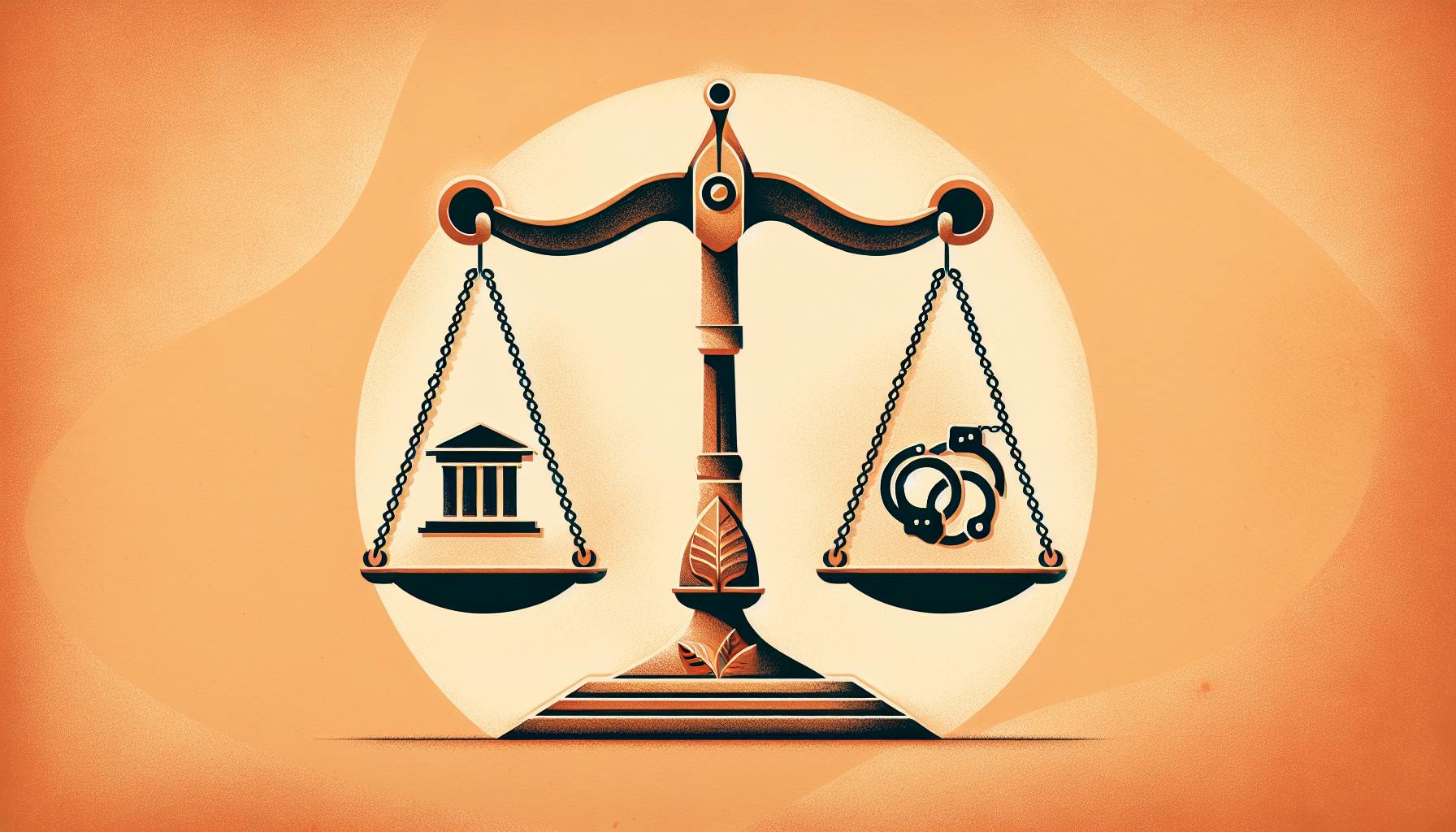Most can agree that corporate fraud harms countless innocent people.
Yet the details on Enron's collapse and Jeffrey Skilling's role often remain unclear. This article promises to shed light by unraveling the deception behind Skilling's rise and fall as Enron's CEO.
You'll see how Skilling architected an illusion of success through dubious ventures like the Raptor accounts, making Enron appear profitable when it wasn't. You'll also learn about Skilling's fraud indictment, the testimonies against him, and his ultimate conviction and sentencing to 24 years in prison for his central role in destroying people's lives and futures.
Introduction to the Enron Scandal and Skilling's Role
Enron was an energy trading company that experienced meteoric growth and success in the 1990s. At its peak, Enron was one of the largest companies in the United States and considered an innovator in the energy sector.
However, behind the scenes, Enron was using fraudulent accounting practices to hide billions of dollars in debt and make the company appear far more profitable than it actually was. When the extent of the fraud was revealed in late 2001, Enron quickly unraveled in what was then the largest corporate bankruptcy in history.
Jeffrey Skilling was a central figure in Enron's rise and fall. As CEO of Enron in the lead up to the company's collapse, Skilling championed the use of complex, opaque business practices and special purpose entities that allowed Enron to hide huge debts and losses from investors and regulators. While Skilling claimed ignorance of the fraudulent activities, he cultivated a culture that incentivized unethical practices in pursuit of profits and market domination.
Skilling's pivotal role at Enron, his intimate knowledge of the company's operations, and his promotion of dubious business practices that contributed to the firm's downfall, made him a prime target for prosecution following Enron's bankruptcy. The Department of Justice brought Skilling up on over 30 charges relating to conspiracy, fraud, insider trading and making false statements to auditors.
What was the downfall of Enron?
Enron's downfall was ultimately caused by poor corporate governance and leadership.
Specifically, former Vice President Sherron Watkins raised concerns about questionable financial practices occurring within the company. However, her warnings went unheeded by CEO Jeffrey Skilling and founder Kenneth Lay. This breakdown in oversight and accountability allowed high-risk accounting maneuvers to go unchecked.
For example, Enron created offshore entities known as "Raptors" to hide losses and debt off the company's balance sheet. This made Enron appear far more profitable than it actually was. Enron also engaged in fraudulent energy trading schemes to manipulate California's electricity market.
The unethical corporate culture centered around pursuing short-term profits and share price at all costs. When Enron's extensive accounting fraud could no longer be sustained, the company collapsed into what was then the largest corporate bankruptcy in U.S. history in 2001. Thousands of employees and shareholders lost their livelihoods and life savings.
Ultimately, the Enron scandal revealed the immense destruction that can occur when corporate governance fails and leadership loses sight of ethical responsibility. The case led to sweeping regulatory reforms like Sarbanes-Oxley to improve accountability and transparency in public companies.
What did Jeffrey Skilling do to Enron?
Jeffrey Skilling was the CEO of Enron Corporation, an energy trading company based in Houston, Texas. Under his leadership from February 2001 to August 2001, Skilling promoted aggressive accounting practices and complex partnership deals that ended up contributing to Enron's downfall.
Specifically, Skilling:
-
Pushed the company to use mark-to-market accounting, which allowed Enron to record projected profits from deals immediately rather than when they materialized. This made the company appear more profitable than it was.
-
Oversaw the creation of complex partnerships and special purpose vehicles to hide company debt and inflate profits. This provided a false picture of Enron's financial health.
-
Misled investors and regulators about the nature of these partnerships and vehicles. He did not properly disclose the amount of debt and risk associated with them.
In 2006, Skilling was convicted of multiple counts of conspiracy, insider trading, making false statements, and securities fraud relating to these actions. He was sentenced to 24 years in prison and fined $45 million for his central role in perpetrating the massive Enron accounting fraud that led to the company's bankruptcy.
What was the cause of Enron's overnight collapse?
Enron's collapse was the result of years of concealed financial losses stemming from poor investments and fraudulent accounting practices. The company had cultivated a corporate culture that prioritized rapid growth and profits over ethics and transparency.
Several key factors contributed to Enron's downfall:
-
Questionable accounting practices: Enron used complex accounting maneuvers like mark-to-market accounting and off-the-books partnerships to hide billions in debt and losses from failed deals.
-
Lack of oversight: The board of directors and auditors failed to question dubious accounting practices and transactions that enriched executives.
-
Toxic culture: Enron incentivized unethical behavior by emphasizing profits and stock price above all else. This culture was dominated by greed and a win-at-all-costs mentality.
In October 2001, Enron was forced to disclose $638 million in losses, revealing the deception. Investor confidence plunged along with stock value. Enron filed bankruptcy within two months as the extent of fraudulent activities and concealed losses came to light. The scandal demonstrated the catastrophic consequences of prioritizing growth over ethics to the detriment of shareholders and employees.
How much did people lose with Enron?
Enron's collapse resulted in massive losses for employees, retirees, and investors. Specifically:
-
20,000 employees lost their jobs when Enron declared bankruptcy in December 2001. This led to sudden unemployment and financial hardship for thousands of workers.
-
Employees also lost $1.2 billion in retirement funds that were invested in Enron stock. Many had significant portions of their 401(k) retirement accounts invested in company shares. As the stock price plunged from over $90 per share to less than $1, those retirement savings were wiped out.
-
Retirees lost $2 billion in pension benefits they were relying on for income. Enron underfunded and ultimately terminated the employee pension plan as part of its bankruptcy.
-
Investors lost tens of billions as Enron's share price plummeted from its peak. The company had a market valuation of over $60 billion before its collapse.
The human impact was immense, with employees and retirees suddenly losing livelihoods, nest eggs, and pension income they had counted on. The financial toll also extended to shareholders and Wall Street more broadly. At the time, it stood as the largest bankruptcy and one of the biggest corporate frauds in U.S. history.
Jeffrey Skilling: The Architect of Enron's Downfall
Skilling's Rise to CEO
Jeffrey Skilling joined Enron in 1990 after working as a consultant at McKinsey & Company. He quickly rose through the ranks at Enron, becoming CEO in February 2001 after serving as President and Chief Operating Officer.
Skilling was known for his ambitious vision to transform Enron into "The World's Greatest Company" through innovative trading and risk management strategies. He led the expansion of Enron's trading operations and the development of new business lines like Enron Energy Services.
Enron's Business Ventures Under Skilling
As CEO, Skilling oversaw major new Enron divisions focused on commodities trading and energy services:
- Enron Energy Services aimed to provide energy management services to commercial and industrial customers
- Enron International expanded commodity trading and infrastructure development overseas
- Enron Broadband Services entered the high-speed internet and telecom markets
These new businesses relied heavily on complex accounting techniques and financial structures promoted by Skilling.
The Raptor Accounts and LJM Partnerships
Skilling approved the creation of LJM Cayman LP and LJM2 partnerships run by Enron CFO Andrew Fastow. These entities allowed Enron to engage in risky investments while keeping hundreds of millions in losses off its books.
The Raptor accounts involved hedging arrangements between Enron and the LJM partnerships. These enabled Enron to hide deteriorating finances and inflate earnings at shareholders' expense.
Skilling's Vision and the Illusion of Success
Skilling created a performance-driven culture focused on innovation, but with little regard for ethics or accountability. He pushed aggressive expansion plans and earnings targets that relied on questionable accounting maneuvers.
While Enron appeared immensely profitable on paper, the company's financial position was precarious. Skilling's ambitious vision ultimately fostered an illusion of success that covered up fraudulent activities and massive losses.
sbb-itb-e93bf99
sbb-itb-e93bf99
sbb-itb-e93bf99
sbb-itb-e93bf99
The Legal Onslaught: Skilling's Indictment and Trial
Skilling faced an extensive list of charges relating to his role at Enron. The legal proceedings, lasting years, highlighted the extent of the scandal and its impact.
Skilling Indictment and Charges
Skilling was indicted on over 30 charges of conspiracy, securities fraud, lying to auditors, and insider trading. The indictment alleged that he conspired to artificially inflate Enron's stock price through illegal accounting tactics, misleading investors and regulators. Specific charges focused on the use of off-the-books partnerships to hide losses and debt.
The Role of U.S. District Judge Sim Lake
Judge Sim Lake presided over Skilling's trial, making several key rulings. He approved the government's request to move the trial due to extensive media coverage in Houston that could bias jury selection. Lake ruled the jury did not need to unanimously agree on which specific acts constituted honest services fraud. He also allowed admission of co-conspirator statements.
Enron Trial Exhibits and Testimonies
Prosecutors introduced extensive documentary evidence from Enron's financial records and emails showing awareness of improper accounting. Testimonies from Andrew Fastow and other executives described Skilling's direct involvement in schemes like the LJM and Raptor partnerships used to manipulate earnings.
The Testimonies of Andrew Fastow and Other Key Witnesses
As CFO, Andrew Fastow's testimony provided direct evidence of Skilling's participation in fraudulent activities. Fastow described Skilling's advocacy for transactions like the Raptors, which Fastow admitted served no purpose other than manipulating Enron's books. Executives Richard Causey and Ben Glisan also testified against Skilling regarding his knowledge and direction of earnings manipulation.
The Prosecution's Narrative: Unraveling Skilling's Deception
The prosecution, led by Sean Berkowitz and Kathryn Ruemmler, presented a compelling case alleging that Jeffrey Skilling engaged in accounting fraud and conspiracy at Enron.
Prosecution Lambastes Enron Defendants in Closing Arguments
In their final statements to the jury, prosecutors emphasized Skilling's role as CEO and COO in perpetuating the massive fraud that led to Enron's bankruptcy. They highlighted evidence of Skilling's involvement in illegal accounting tactics, including the use of off-the-books partnerships to hide losses. The prosecution portrayed Skilling as the mastermind behind a web of lies and deception.
Taking the Stand: Skilling Denies Accounting Fraud
When Skilling took the witness stand in his own defense, he steadfastly denied any knowledge of or participation in fraudulent accounting practices at Enron. He testified that he relied in good faith on assurances from subordinates that the company's financial statements were sound. Prosecutors confronted Skilling with evidence that contradicted his statements.
Former Enron Chairman Blames Others for Collapse
Kenneth Lay, Enron's founder and chairman, pursued a defense strategy of blaming others for the company's demise, including former CFO Andrew Fastow. However, prosecutors maintained that as CEO and later chairman, Lay must have known about the fraud. This line of argument also implicated Skilling as second-in-command.
The Marketplace Report: Enron Trial Set for Jury
After months of testimony, the prosecution rested its case alleging Skilling's pivotal role in perpetrating the Enron fraud. The case then went to the jury for deliberations on the charges of conspiracy, securities fraud, wire fraud, insider trading and lying to auditors. Skilling's fate hung in the balance awaiting the jury's verdict.
The Defense's Strategy: Challenging the Prosecution's Case
The defense, led by attorney Daniel Petrocelli, pursued an aggressive strategy to undermine the prosecution's case against Skilling. Their approach focused on discrediting key witnesses and highlighting inconsistencies in the evidence presented.
Daniel Petrocelli's Passionate Rebuttal for Skilling
Petrocelli delivered impassioned closing arguments, insisting that Skilling did not commit any crimes in his leadership of Enron. He maintained that Skilling made decisions he believed were in Enron's best interests rather than to intentionally defraud investors. Petrocelli emphasized that the prosecution failed to prove criminal intent beyond a reasonable doubt.
Challenging the Credibility of Prosecution Witnesses
A core tactic was attacking the credibility of prosecution witnesses like Andrew Fastow. Petrocelli scrutinized inconsistencies in Fastow's testimonies and portrayed him as an admitted liar who cut a plea deal to avoid prison time. This strategy aimed to undermine his damning allegations against Skilling.
Skilling's Testimony at Odds with Prosecutor's Facts
In his testimony, Skilling disputed several key points made by the prosecution about Enron's financial practices and his knowledge of improper accounting. Petrocelli used this to highlight contradictions between Skilling's account and the prosecution's version of events.
Enron Defense Delivers Passionate Rebuttal
In their closing statement, Petrocelli insisted Enron was the victim of a "run on the bank" and market overreaction - not fraud. He implored jurors not to make Skilling a "human sacrifice" for wider economic forces beyond his control. However, this emotional appeal ultimately failed to persuade the jury.
The Verdict: Skilling Sentenced to 24 Years in Prison
Skilling was convicted on 19 counts of securities fraud, wire fraud, insider trading, conspiracy, and making false statements in SEC filings. He was sentenced to 24 years and 4 months in federal prison and ordered to pay $45 million in restitution.
Jury Declares Lay and Skilling Guilty of Fraud
The jury unanimously found Skilling guilty on 19 counts and Lay guilty on 6 counts of conspiracy and fraud. This established criminal liability at the highest levels of Enron's leadership for the company's collapse. The verdict sent a strong message that corporate executives will be held accountable.
U.S. Court Orders Skilling Resentenced
A federal appeals court ruled Skilling should be resentenced due to a flawed legal rationale regarding the sentence length. The resentencing reduced his prison term to 14 years. Skilling appealed to the Supreme Court but the conviction was upheld.
U.S. Appeals Court Upholds Jeff Skilling Conviction
Skilling filed multiple appeals seeking to overturn his conviction but was ultimately unsuccessful. An appeals court rejected his argument that his trial was unfair due to negative publicity. His conviction on conspiracy, fraud and insider trading stood.
Judge Vacates Conviction of Ken Lay
Since Lay died before exhausting his appeals, his conviction was vacated. However, the jury's guilty verdict remained on record, affirming Lay's central role in perpetrating the Enron fraud scheme.
The Aftermath of Enron's Downfall
Enron's collapse had wide-ranging impacts on corporate governance, financial regulations, and public trust in business. The scandal exposed flaws in accounting and oversight that shook investor confidence.
Sarbanes–Oxley Act: A Legislative Response to Enron
In response to Enron and other corporate scandals, the Sarbanes-Oxley Act was passed in 2002 to reform accounting practices and prevent fraud. Key provisions included:
- Establishing the Public Company Accounting Oversight Board to oversee auditors
- Stricter independence rules for auditors
- Enhanced financial disclosures and internal controls for public companies
- New rules regarding corporate responsibility and financial reporting
The act aimed to improve transparency and hold executives more accountable.
Enron and the Fall of Arthur Andersen
Arthur Andersen, Enron's auditor, was convicted of obstructing justice for destroying documents related to its auditing of Enron. The firm surrendered its CPA licenses and its clients. By 2002, the "Big Five" accounting firms had become the "Big Four."
The demise of a major auditing firm highlighted the need for reform to prevent conflicts of interest. Auditors are now prohibited from providing consulting services for the same clients.
The Cultural Impact: Books and Films on the Enron Scandal
Enron has been the subject of many books and films examining corporate greed and failed oversight. These include "The Smartest Guys in the Room" book and documentary, recounting insider accounts and probing the hubris behind Enron's rise and fall.
Other works like "Conspiracy of Fools" and "Enron: The Smartest Guys in the Room" film have analyzed how lack of transparency and accountability contributed to the company's implosion.
Reforming Corporate Governance Post-Enron
Enron led to tighter scrutiny and restraints on corporate behavior. Executives and directors face harsher penalties for misconduct. Boards must now have a majority of independent directors, and added oversight committees on auditing and executive compensation.
The reforms have aimed at greater checks and balances to protect shareholders and employees from excessive risk-taking and fraud. However, questions linger regarding sufficient implementation and enforcement of governance rules.
Conclusion: Reflecting on the Legacy of the Enron Scandal and Skilling's Trial
The trial of Jeffrey Skilling marked a pivotal moment in American corporate history. As CEO of Enron, Skilling presided over one of the largest corporate frauds and bankruptcies in modern times. His conviction on charges of conspiracy, securities fraud, and insider trading symbolized a measure of justice for investors and employees who lost billions in the company's collapse.
The Enron scandal shone a harsh light on unethical practices that had become endemic in corporate America. Deceitful accounting, rapacious greed, and an utter lack of concern for anything beyond short-term profits combined to fuel the company's meteoric rise and catastrophic fall. In the aftermath, the Sarbanes-Oxley Act ushered in an era of stricter oversight and accountability for public companies and their executives.
While Skilling continues to maintain his innocence, his 24-year prison sentence and the $45 million fine levied serve as a warning for other executives who may be tempted to put personal gain ahead of ethical behavior. The corporate world is still grappling with many of the issues laid bare by Enron's failure over 20 years ago. However, the enduring legacy of Skilling's trial is to reinforce the need for integrity, transparency and responsible leadership at the highest levels of business. The fates of Skilling, Lay and others involved with Enron illustrate all too clearly the consequences of unchecked greed.


